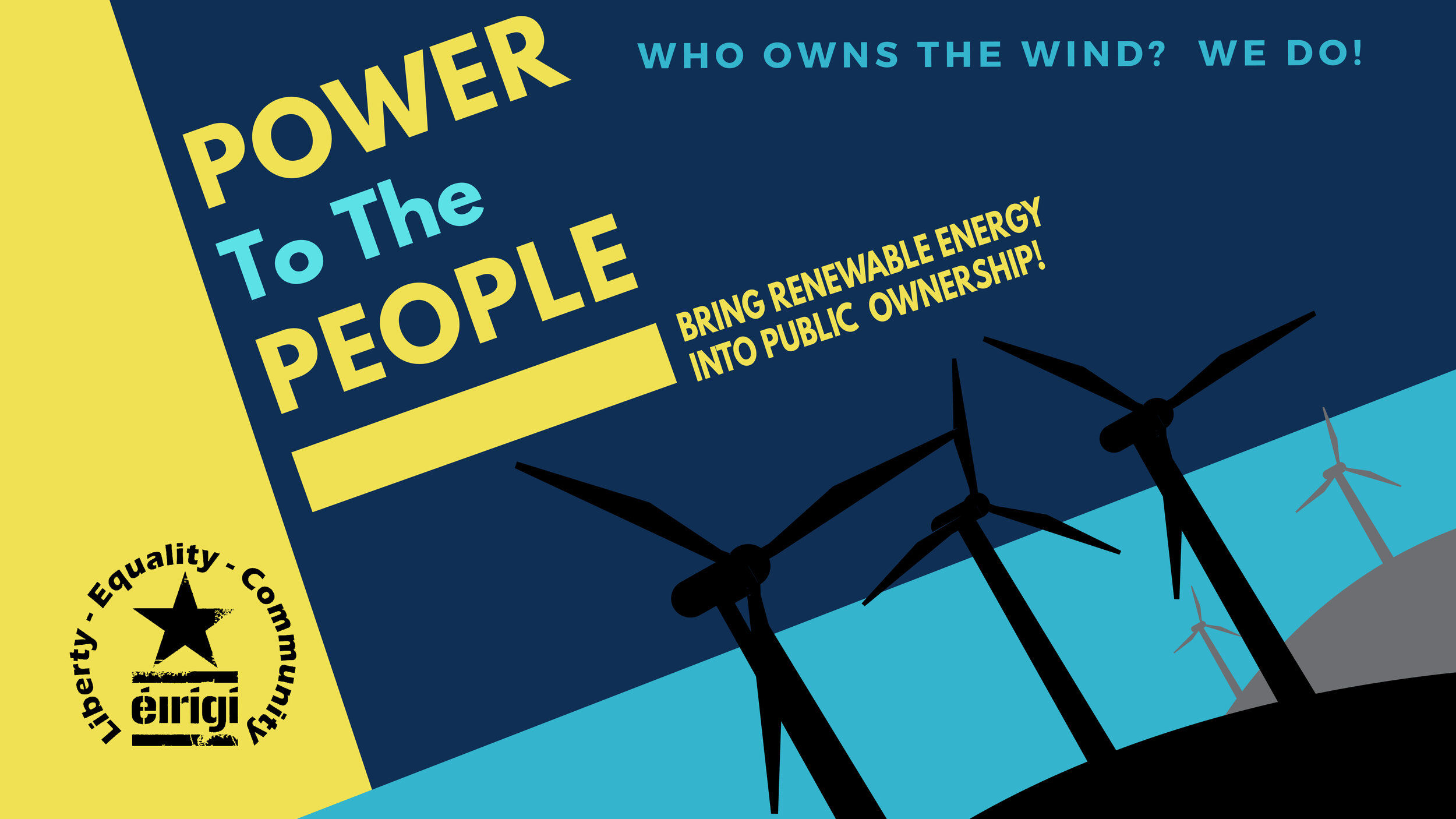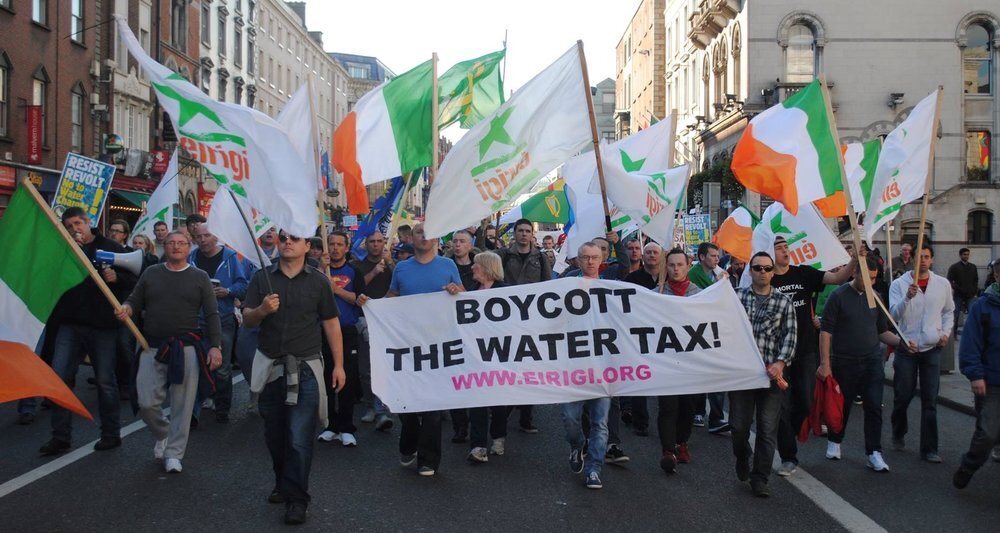Power To The People!
Bring Renewable Energy Into Public Ownership
The reality of human-driven climate change is undeniable. The temperature of our planet is increasing as a direct result of human activities that generate huge quantities of greenhouse gases. Among the most damaging of these gases is the carbon dioxide that is released from the burning of fossil fuels such as oil, gas and coal.
The Irish political establishment is proposing to reduce the current reliance on fossil fuels through the imposition of regressive, crude carbon taxes and by handing Ireland’s vast renewable energy potential to the private sector.
Éirígí For A New Republic is fundamentally opposed to this approach because it will be neither effective or fair. Instead we are advocating for a radically different approach based on the following principles:
That wind, solar, wave, tidal, hydro and other forms of renewable energy are recognised as the product of a natural resource which belongs to the nation and from which the nation must collectively benefit.
That the state directly develops sufficient wind, solar and other renewable energy sources to allow for a transition to a low carbon economy by 2030.
That existing privately-owned sources of renewable energy are nationalised and integrated into the new publicly-owned renewable energy network.
That the state heavily invests in the research and development of energy storage and new renewable energy technologies, with a particular focus on wave and tidal technologies which are particularly suited to Ireland.
That the state shall provide low cost and even free electricity to citizens to assist them make the transition away from fossil fuel based transport, heating and cooking.
The Shift to Green electricity
In 2017, over 30% of electricity generated in the Twenty-Six Counties came from renewable energy sources - primarily wind. The equivalent figure for the Six Counties in 2019 was an even more impressive 44%. (data courtesy of SEAI and NISRA).
Unfortunately, electricity generation accounted for just 21% of overall energy consumption in 2017, with 42% being used for transport and the remaining 37% being used for heating. As a result, 89% of the energy used in 2017 still came from fossil fuels (data courtesy of SEAI).
Achieving a low carbon economy by 2030 will require a dramatic shift towards electric powered transport and heating. And an equally dramatic increase in the supply of electricity generated by wind, solar and other non-fossil fuel sources.
The scale of the threat posed by climate change requires the state to take the lead in rapidly developing a network of major new wind and solar facilities in the next decade. It is simply too important to be left to the whims of a private sector that has failed to deliver to date.
The private sector has delivered just seven offshore wind turbines, despite planning permission having been granted almost twenty years ago to erect hundreds.
private sector has failed to deliver
The neo-liberal doctrine that the political establishment so slavishly follows dictates that the private sector and private markets should control the supply and price of energy. Private energy companies have thus been left in charge of providing the solution to an existential threat to our environment, ecosystem and our civilization.
As far back as 2002, the private sector was granted permission to erect 200 wind turbines off the coast of Arklow. A year later, in 2003, surveying began for the proposed Oriel Wind Farm off the coast of Dundalk. In 2005 planning permission was granted for the Codling Park Wind Farm, a 220 wind turbine development off the coast of Greystones. And the list goes on.
In total the private sector has developed plans for Irish offshore wind farms with the capacity to power over five million homes - enough for every homes on the island of Ireland and two million more besides.
Many of these plans have been in development for close to twenty years and some have been granted full permission to proceed. And yet only seven turbines have actually been erected offshore. While the private sector has been more successful at delivering onshore renewable energy, it has still fallen far short of the levels that will be required to reach a low carbon economy by 2030.
The cause of this failure is easily explained. Private companies exist to generate maximum profit in the short term, not to save the planet from long-term threats. The state alone has the motivation, land, finances, legal powers and other resources to deliver the dramatic increase in green electricity that is needed before 2030.
Solar farm in Co Antrim. Wind and solar technology is now efficient, reliable and cost-effective. Ireland is well positioned to exploit both wind and solar in a combined, complimentary manner.
Ireland is well positioned
Ireland’s geography leaves the country particularly well positioned to meet the twin challenges of climate change and the transition to renewable energy. Exploiting these natural advantages with different, complimentary forms of renewable technology will provide Ireland with an ample and consistent supply of green electricity.
As an island nation on the edge of the Atlantic Ocean, Ireland has a consistent supply of wind as well as ample onshore and offshore sites for the wind turbines that can harness it.
Solar is another proven renewable technology that is suited to Ireland, particularly during the long daylight hours of summer when the supply of wind energy may be relatively low.
Ireland’s close proximity to the major populations of Britain and continental Europe provide a ready market to which excess green electricity can be sold. The same inter-connectors can also be used in reverse during periods of low energy production in Ireland.
When the technology to harness the power of the waves and the tides reaches maturity in the coming years, Ireland will have an additional major source of renewable energy.
The enforced move to renewable energies may inadvertently provide Ireland with the energy independence that it has been historically denied. Such energy independence will prove to be of particular value during the period of increased geo-political instability that climate change will cause.
With the correct planning, investments and international partnerships Ireland could move beyond energy independence to become a major net exporter of green electricity to Britain and continental Europe.
Peaceful opposition to handover of the Corrib Gas Field to Shell was met with state violence
Who owns the wind?
The discovery of the Corrib Gas Field off the coast of Co Mayo in 1996 ignited a national debate about who should own and benefit from Ireland’s natural resources. On one side was the political establishment which gifted the Corrib reserve to Shell and its partners. And on the other side was a loose coalition of individuals and organisations, including Éirigí, that wanted Ireland’s oil and gas reserves to be held in public ownership and used for the collective good.
The opposition to Shell took many forms including legal challenges, mass protests, awareness raising and peaceful direct actions. The response of the corporate media, political establishment and state to this resistance was as predictable as it was vitriolic and violent. At the height of the campaign in November 2006 dozens of Gardaí batoned, kicked, punched and dragged people from the road outside the site of Shell’s proposed gas refinery in Ballinaboy.
Now the Corrib reserve is being slowly emptied of natural gas worth billions of euros, Not one cent has been paid in corporation tax by the companies that control it. And the people of Ireland are paying the same for the gas as they would for gas from Norway or Russia.
In 2014, eight years after the Gardaí punched, kicked and dragged protesters off the road in Mayo, the issue of control of Irealnd’s natural resources was again dominating headlines. On this occasion the resource was water and the battle was focused on the introduction of a water tax - a prerequisite to the eventual privatisation of water resources and water services.
The response of the corporate media, political establishment and state to the anti-Water Tax movement closely echoed their response to the campaign to keep the Corrib Gas in public ownership. On this occasion, however, the weight of popular opposition to the Water Tax forced the political establishment to retreat, at least temporarily.
Éirigí block at Right 2 Water protest in Dublin City Centre
Power To the people
Éirígí’s Power To The People campaign hopes to spark a national conversation about Ireland’s wind, solar and other energy-producing natural resources. The profits that could potentially flow to private companies from these renewable natural resources could dwarf the profits arising from a non-renewable resource such as the Corrib Gas Field.
Why should some of the same energy companies that have actively denied human-driven climate change now be allowed to control the pace of transition to renewables?
Why should some of the same energy companies that profited from driving climate change make even more profits from renewables?
Why should the people of Ireland surrender strategic control of energy to private corporations as humanity enters a phase of unprecedented challenges arising from climate change?
Éirígí' believes that the state, acting on behalf of the Nation, should rapidly develop and permanently control a national network of wind, solar and other renewable energy facilities.
The electricity that is generated from these facilities should be used for the collective good, not private profit. In the current context the collective good involves using that green electricity to achieve a rapid transition away from fossil fuels.
The political establishment are proposing to use the ‘stick’ of carbon taxes in isolation from any meaningful ‘carrot’ to assist citizens make the transition from fossil fuels to renewables.
By controlling the generation of green electricity, the state would be in a position to provide extremely low cost electricity to power the LUAS, DART and a fleet of electric buses. And similarly it would be able to offer citizens the ‘carrot’ of low-cost electricity to help them make the transition away from fossil fuel based personal transport, heating and cooking.
If you’re interested in helping the Power To The People campaign please get in touch via the contact form on this page.
Power To The People, the energy that is generated from Ireland natural resources should be used to assist citizens to move away from fossil fuels







